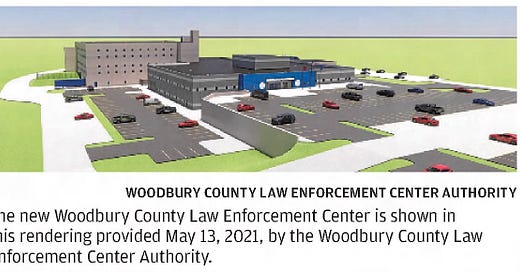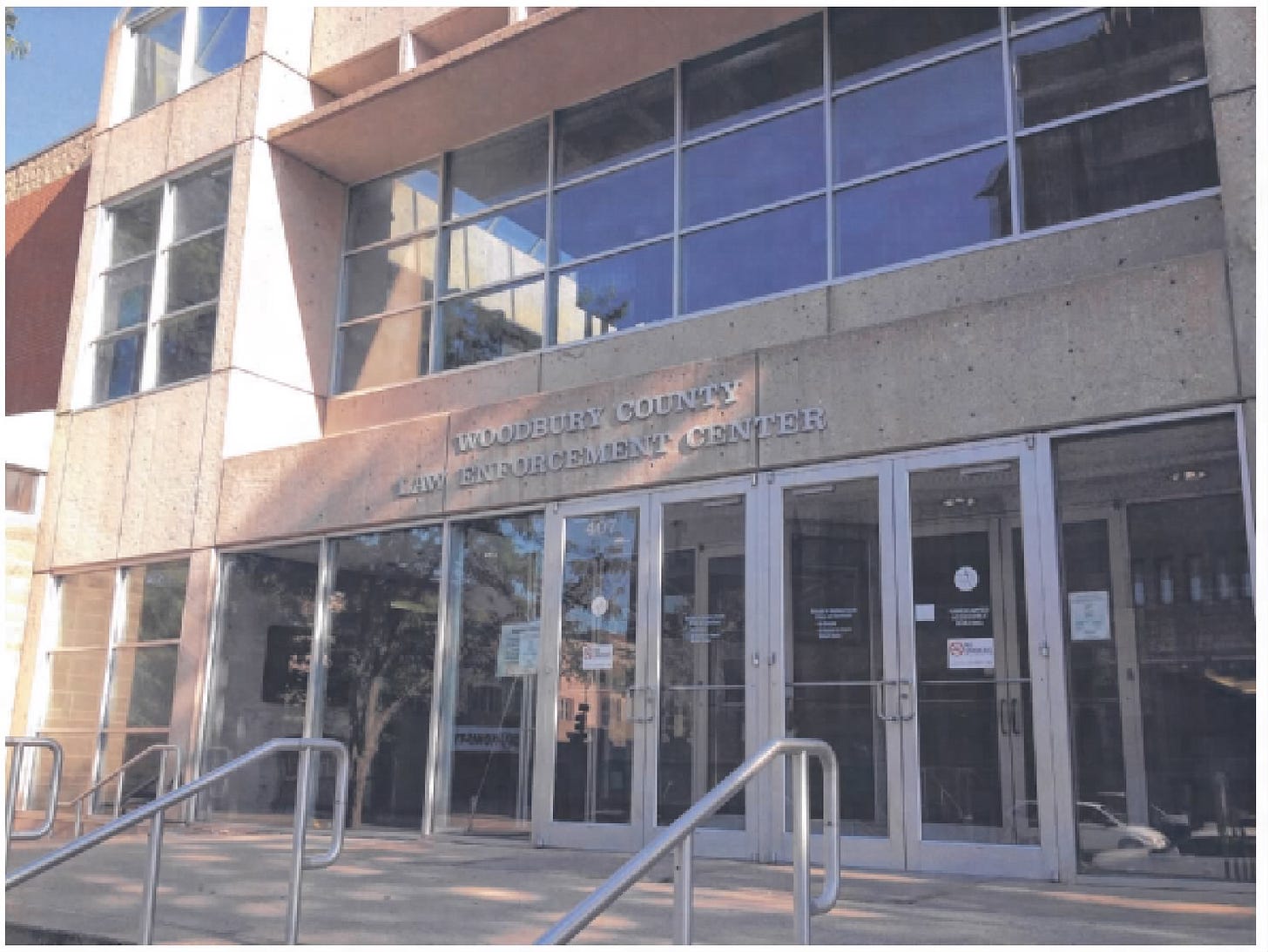The pair of buildings rising at local taxpayer expense in a field northeast of Sioux City grew out of an idea that would have cost $1.2 million when it was offered 10 years ago. Over time, the idea transformed into something entirely different, a new jail facility with what would become an eye-popping price tag.
The situation has caught the attention of many in Sioux City and may be a cautionary tale for other communities planning major civic improvements.
The story begins in about 2011, when the current county jail, built in 1987, began to show a bit of age. The idea of updating the building, specifically, the security technology, was put on the table. It seemed logical. There had been significant advancements in security technology during the 24 years since the jail had been built. It was not long, however, before the jail’s heating, cooling, and ventilation systems began to need some attention. As anyone who ever has owned a house or a building knows, these systems have limited lifespans and need periodic replacement.
Sioux City’s current 1987 county jail and Law Enforcement Center. Sioux City Journal photo.
The first estimate of the cost of needed improvements came in 2013, dealing only with the security technology: $1.2 million. The number grew rapidly and dramatically as the replacement of mechanical systems was added into the total: $10 million, $14 million, $22 million… Whoa. Stop. Maybe the jail should be replaced, not updated, some said. The idea began to catch on.
By this time, it was about 2019. The cost estimate for a new jail was put at $43 million. It was about double the top-end estimate for updating the old jail, but there were thought to be offsetting advantages. Among other things, a new jail could be larger and could be designed to meet the more stringent security requirements for housing federal inmates. It might actually generate income with the federal government paying the Woodbury County Law Enforcement Authority a daily stipend for every federal prisoner sent its way. Except it did not quite turn out that way. The Sioux City Journal reported in a recent article, which provided a detailed look at the jail project, that the revenue budgeted for housing federal inmates during the first fiscal year of operation would be $1.2 million. But the 18 additional employees needed to operate the larger jail will cost $1.3 million a year. No further comment necessary. The numbers speak for themselves.
It was clear from the beginning that the money to build a new jail would have to come from a bond issue repaid with local property taxes. Under Iowa law, most bond issues that are financed by property taxes require a vote of the people with 60 percent approval. Few thought that 60 percent of the voters in Woodbury County would vote to pay more property taxes for a new jail. But then, Woodbury County found a way to sidestep the 60 percent requirement. Bonds issued by joint government authorities involving multiple governmental units can be approved by a 50 percent favorable vote. Sioux City and Woodbury County, thus, entered into a joint agreement creating the Woodbury County Law Enforcement Authority. It would have its own governing board and would build and own the new jail.
The bonding limit of these joint authorities, however, is $50 million. Fine. The original $43 million estimate had grown, of course, but at $49.3 million, it would be a perfect fit. Unfortunately, but not surprisingly given the history of this project, that number was only the beginning. It quickly soared: to $50.3 million, then to $58.4 million, which was the lowest of the two bids received from contractors for the project. Then it jumped again, to $68 million, and most recently to $70 million.
Interestingly, the low-bid contractor was based in Lincoln, Nebraska, and would bring in many of its workers via a national website on which tradespeople from all over the country register to find work. Ernie Colt, the business representative for the carpenters union in Sioux City, originally was a strong supporter of the new jail, in part because of the jobs it could generate for local workers and the boost it might provide for the local economy. However, the one Sioux City-based construction company that bid on the project was underbid by $900,000 by the only other bidder, a construction company from Lincoln. And, yes, Iowa does have a law requiring that the low bidder be awarded the contract, all other things being relatively equal. Because both bids were so far over the estimated cost, Cole urged the authority to reject them both, take a hard look at ways to trim costs, and then rebid the project. He said he got no support for that proposal. The authority accepted the $58.4 million bid.
But then came change orders and cost overruns and COVID-19. The latter also brought significant levels of inflation and product shortages. The cost kept rising: $68 million, then $70 million – a 63 percent increase over the original estimate. To cover the increased costs, the city and the county agreed to use $10 million each over a two-year period from their COVID-19 federal emergency funds. Not everyone in Woodbury County thought that was a good idea or within the spirit of what they thought that money was intended for. There were few limits, however, on how cities and counties could spend the money.
From Sioux City Journal. Building in the foreground is the office facility for sheriff, county attorney, and courts. Building in background is the jail.
The story of the troubled construction problem continues: The construction start dates were delayed, and, naturally, the completion dates as well. The two buildings – a jail and offices for three related departments, sheriff, county attorney, and courts -- were supposed to open on September 14, 2023. That did not happen. The buildings now are scheduled to open on April 9, 2024. “Terrible news,” Matthew Ung, chair of the county Board of Supervisors, told the Sioux City Journal. The most recent delay was caused by a discovery fire dampers, required for jails, had not been included in the building plans. They would have to be added. Translation: more time and more money.
Finally, in what may be one of the more outrageous decisions related to this project, the Woodbury County Law Enforcement Authority has, in effect, declined to allow public access to the construction site. No visitors are allowed to tour the facility without submitting to 10 hours of safety training and obtaining prior approval from the sheriff’s office, the authority, and the contractor, the Journal reported last month. If they do get approval, they cannot take their cell phones with them onto the work site. Not even county supervisors or employees who will be working there have been able to see the buildings up close. Ron Wieck, chair of the authority, said, in effect, that the authority is intentionally making it extremely difficult for anyone not connected with the project to see close-up what is going on. He told the Journal that visitors are a security concern and would divert the construction staff from its work.
I’m sorry, Mr. Wieck, your job as a public official includes keeping the public informed about what’s going on relating to your job. And given that your only job right now is building a new $70 million jail that is way over budget, it is reasonable to expect that at least city officials, county officials, journalists, and perhaps others will be able to see the project up close.
As for prohibiting cell phones in the hands of visitors who may get access, the only conclusion that can be reached is that you have something to hide, something very bad that is going on that you do not want to have photographed.
Gary Lipschutz, a Sioux City retiree, has been following the jail saga closely and has many questions about it. “Who was asleep at the switch? Who wasn’t watching the tax dollars?” he asked. “Nobody,” he added, “seems to be able to come up with a very good answer to that.”
The Iowa Writers’ Collaborative
Have you explored the variety of writers in the Iowa Writer’s Collaborative? They are from around the state and contribute commentary and feature stories of interest to those who care about Iowa. Please pick five you’d like to support by becoming paid. It helps keep them going. Enjoy:






Thank you for covering this important story!
Now that’s how investigative reporting is done! Nice work, Arnie!